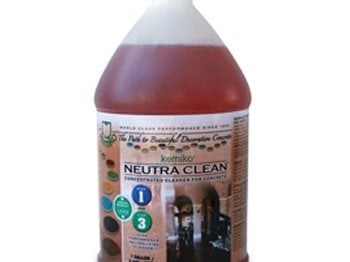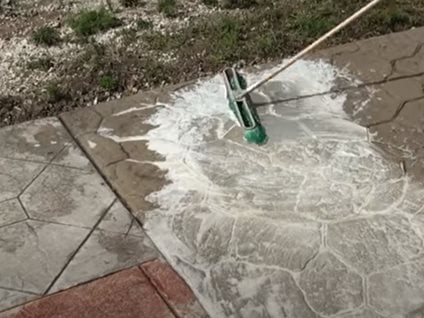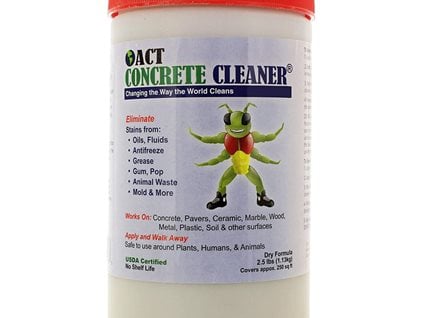- Concrete Cleaning Home
- Choosing a Concrete Cleaner or Degreaser
- How to Clean Exterior Concrete
- Concrete Cleaning Chemicals
- Pressure Washing Concrete
- Cleaning and Sealing Exterior Concrete: A Guide to Maintaining and Caring for Exterior Decorative Concrete of all Types
- Tips for Maintaining Exterior Concrete
- How to Clean Concrete
- How to Clean Concrete Floors
- How to Clean a Concrete Patio
- Cleaning a Concrete Driveway
- Cleaning Stamped Concrete
- Pool Deck Cleaning
- How to Clean Concrete Countertops
- How to Remove Stubborn Stains and Discoloration
- Advice on Cleaning Concrete Countertops, from Concrete-Countertops.org
- Related Information:
- Concrete Sealers
Choosing the Best Concrete Cleaner or Degreaser
Learn how the various types of concrete cleaners work and how to choose the best one for your needsA wide variety of cleaners are available that are designed to clean or remove contamination from concrete surfaces. Understanding what these different cleaners do and how they work can save you time and money when cleaning concrete.
First, without going into complex chemistry, let's discuss how a basic soap works. We all know that oil and water do not mix. Soap consists of fatty acids that emulsify oil, grease, and dirt, allowing the particles to be removed with a water-based solution. Without soap, just plain water doesn't have much cleaning ability. By surrounding and entrapping stubborn oil or organic-based dirt, a soap or cleaner allows the grime to be rinsed away more easily.
Find concrete cleaners and degreasers
The origin of basic soap goes back hundreds of years, and today there are a multitude of modern detergents and cleaners to choose from. Some utilize complex chemistry to target specific types of contamination and dirt in a wide variety of environmental conditions.
Even with the best cleaner, good old-fashioned elbow grease and patience really make the difference when removing a stubborn stain from concrete. Concrete is porous, holds dirt well, and can be a tough surface to clean. Doing some research and trying a few different systems can really pay off. Once you find the cleaner that really works, you will cut your time for concrete surface preparation or maintenance in half.
Find a concrete cleaning contractor near me
These are the best types of cleaners and degreasers:
- pH-neutral cleaners
- Acidic cleaners
- Alkaline degreasers
- Enzymatic or bacterial cleaners
- Specialty cleaners
 All-Purpose Concrete Cleaner
Removes sealers and coatings.
All-Purpose Concrete Cleaner
Removes sealers and coatings.
 Cleaner & Degreaser
Starting at $11.95
Cleaner & Degreaser
Starting at $11.95
 Brickform Neutra Clean
A pH neutral cleaner that combines cleaning and light degreasing
Brickform Neutra Clean
A pH neutral cleaner that combines cleaning and light degreasing
 Commercial Surface Cleaners
Cuts through grease and grime. Environmentally friendly
Commercial Surface Cleaners
Cuts through grease and grime. Environmentally friendly
 Kemiko Neutra Clean
Low VOC All Purpose Cleaner. Leed compliant.
Kemiko Neutra Clean
Low VOC All Purpose Cleaner. Leed compliant.
pH-Neutral Cleaners
When to use them: These mild, multi purpose cleaners are primarily designed for cleaning interior sealed concrete surfaces that do not have imbedded dirt. They can also be used on exterior or interior unsealed concrete that only needs a mild cleaning, with no major dirt contamination present. Learn more about cleaning concrete floors.
How they work: These cleaners are typically concentrates that you dilute with different amounts of water, depending on the level of cleaning required. Saturate the concrete surface with the cleaner, followed by scrubbing or light agitation. After a few minutes, vacuum or mop up the residue, followed by rinsing with clean water. If dirt remains, try repeating the process or using a stronger solution.
Where to get them: pH-neutral cleaners are readily available at most specialty concrete distribution outlets, hardware stores, and janitorial supply outlets.
Product to try:
Neutra Clean is a water based, water viscosity, sodium metasilicate concrete cleaner formulated to remove grease, grime, soil, wall plaster and other construction related residue. It is perfect for cleaning stained concrete.
Acidic Cleaners
When to use them: These types of cleaners are primarily designed to remove stains, dirt, and contamination that are soluble in an acidic solution. They are especially effective for removing efflorescence on concrete, an insoluble metallic salt that appears as a white powder or crystalline residue on the concrete surface and will not wash away in plain water. Exposure to hard water, a high salt content in the concrete, and high soil alkalinity are common causes of these types of stains.
How they work: As you might expect, acidic cleaners contain acid as the active ingredient. They come in both concentrated and ready-to-use formulations and are applied directly to the contaminated area. Sometimes scrubbing or agitation is needed, and stubborn stains may need additional applications. It is critical to neutralize the concrete after cleaning with an acid-based cleaner, followed by a clean-water rinse. Consider using a sealer to protect the area from future alkaline or salt contamination.
Where to get them: Acid based concrete cleaners are available at most specialty concrete distribution outlets. Diluting standard muriatic acid is a widely used and accepted type of acidic cleaner. It is important to note that over-the-counter cleaners like Lime Away and soap-scum removers are designed to clean similar types of contamination in a bathroom environment, but do not contain acid, so they may not be as effective on concrete.
Learn more about acid washing concrete.
Product to try:
An environmentally friendly industrial strength floor cleaner, degreaser and light etching product. It is ideal for cleaning and preparing cementitious surfaces for acid staining, decorative overlays, water-based stains, and coatings applications. Can also be used as an efflorescence remover.
Alkaline Degreasers
When to use them: Also known as "concrete degreasers," alkaline cleaners are most often used to remove oil, grease, or other hydrocarbon-based stains. The best degreasers for concrete emulsify, or break down, the oily contamination. The other application for alkaline cleaners is to neutralize concrete surfaces after acid staining or acid cleaning. Alkaline cleaners are the best way to bring the pH of concrete from acidic to alkaline, which is concrete's natural state. Modern alkaline soaps and cleaners far exceed the neutralizing ability of the old-school method of baking soda and water. They are economical too, since 1 gallon of cleaner fully diluted will treat approximately 4,000 square feet of concrete.
How they work: Alkaline cleaners typically come as concentrates and are diluted with water, depending on how aggressive the stain is. Apply the cleaner full strength for deep or older stains, and dilute it for newer stains that haven't penetrated far. Agitation or scrubbing to work the cleaner into the oil or grease stains is critical for good results. When using alkaline cleaners it takes a long time for the cleaner to work. Depending on the type and depth of the oil stain, multiple applications may be necessary, with each being allowed to work for a few hours to get acceptable results. Another important step when using alkaline cleaners is to "lift" the oil stain out of the concrete once the stain has been emulsified. You can use an industrial wet vac, poultice, or rags. Remove the residue with clean water, and reapply more cleaner if needed until the stain is gone.
Where to get them: These types of cleaners can usually be found at concrete distribution outlets or online stores that carry concrete cleaners and degreasers.
Product to try:
BLUE BEAR by Franmar Emerge 700DG
Take all the guess work out of deciding on the best surface degreaser! Specially formulated to be super concentrated and powerful enough to clean the dirtiest, toughest, and grimiest of projects.
Enzymatic/Bacterial Cleaners
When to use them: The newest types of concrete cleaners are those that use organic chemistry and active enzymes to attack, break down, and in some cases digest stains and contamination. They are also known as "oxidation cleaners," with the most popular brand being OxiClean. Generally, they are formulated to break down very specific soils, such as starch-based stains, hydrocarbon-based stains, and protein based stains. For example, eliminating pet urine stains on concrete is a common problem. Using an enzyme cleaner that targets protein (the odor and stain in urine is comprised mostly of protein) is the best way to remove these types of stains. The other type of active cleaner is bacterial. These cleaners use genetically engineered bacteria that actually feed on oil, grease, or hydrocarbons.
How they work: A major benefit to using these types of cleaners is that most do not require water for activation, and there is little or no residue to wash away. The enzyme or bacteria simply consumes the contamination until it's gone. The biggest drawback is that they require time to work. Depending on the size of the contamination or stain, the enzyme or bacteria may require days or weeks to do its job. Most of these types of cleaners are applied directly to the stain with little or no agitation required. For large or stubborn stains, additional applications may be required.
Where to get them: Active cleaners can be a bit harder to find than the other types. Some hardware and home-improvement stores and specialty janitorial supply outlets carry them. I have found that buying a cleaner targeted for the specific stain you're removing yields the best results.
Product to try:
Experience the easiest, quickest concrete cleanup ever while controlling odors. Clean with the same effective processes the oil and gas industry and commercial warehouses use.
Specialty Cleaners
Specialty cleaners remove specific types of contamination and may be a blend of two or more of the four aforementioned cleaner types. Examples of these include rust removers for concrete and non-acid-based efflorescence removers. These products can be hard to find, and I have found that their success varies depending on environmental conditions.










